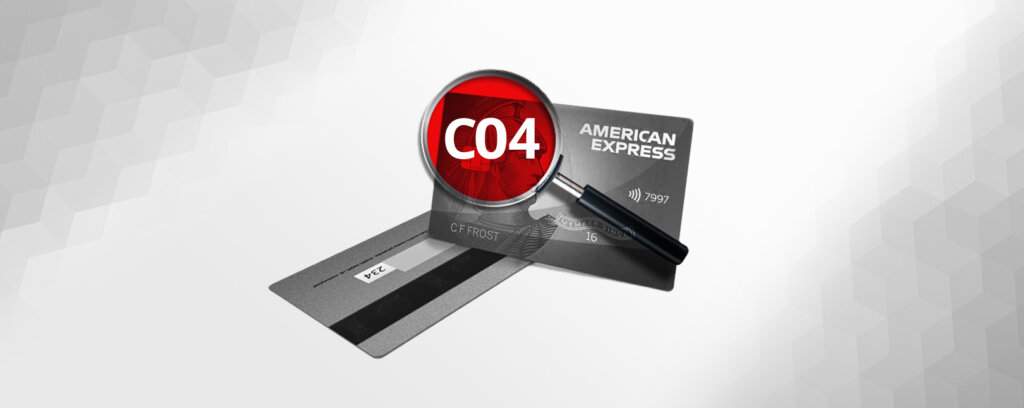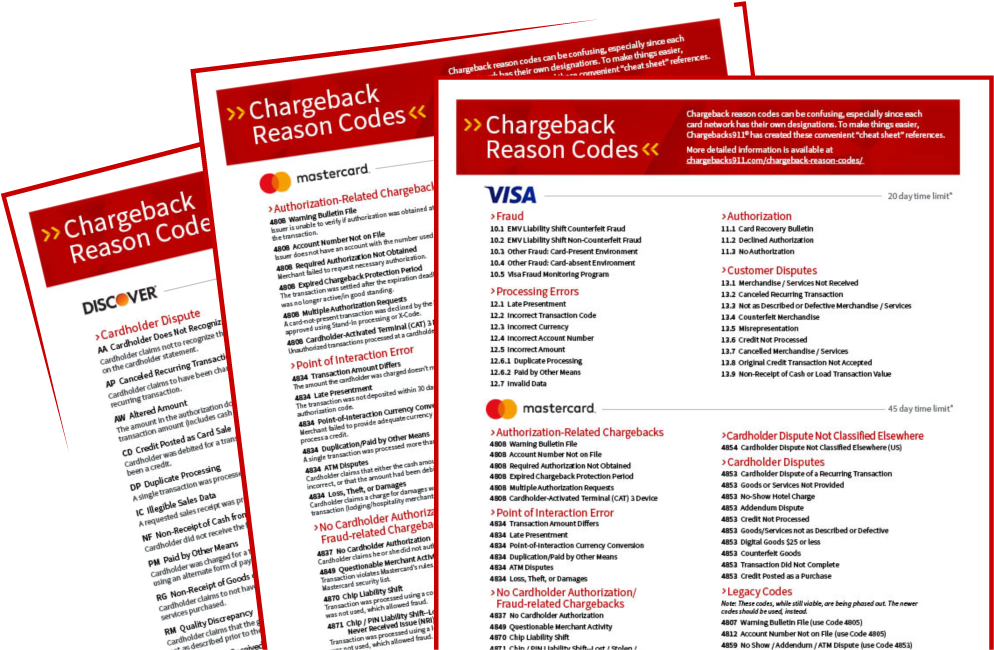
How to Handle Amex Reason Code C04 Chargebacks
American Express breaks down the acceptable causes for a customer to dispute a credit card transaction in their dispute guidelines. This is done for the sake of simplicity and standardization.
Each chargeback trigger has a designated “reason code.” Amex can then assign the appropriate code to each case to show the given reason for the chargeback.
Learn more about Amex reason codes
Today, we’re looking at one reason code in particular — C04 — and exploring the causes, timeframes, fees, and other specifics. We’ll also explore what you can do to prevent these chargebacks from happening.
Recommended reading
- PayPal Account Limitations? Here are 5 Ways to Respond.
- Best Credit Card Processing Companies of 2025 REVEALED
- What Happens When You Dispute a Transaction?
- Spring 2025 Updates to Visa’s Merchant Fee Schedule
- What is Smishing? How to Identify & Prevent SMS Text Scams
- How EMV Chip Cards Work: Pros, Cons, Data Points & More
What is American Express Reason Code C04?
American Express chargeback reason code C04 is “Goods/Services Returned or Refused.” This reason code is used to explain that the Amex cardholder made a purchase, but the goods were ultimately refused or returned. However, the merchant failed to provide a credit.
Like other American Express reason codes, C04 is meant to explain to you, as a merchant, why a chargeback happened. In this case, it suggests that you were expected to provide a credit (i.e. a refund) to a buyer for returned or refused merchandise. But you neglected to do so.
What Caused This Dispute?
Amex Chargeback Reason Code C04 is primarily issued when a cardholder contacts Amex to dispute a charge after not receiving an expected credit. To demonstrate, this scenario can arise if:
- The cardholder returned or refused an item, expecting a refund. However, the refund was never credited to their account.
- The cardholder expected a credit to offset a pending charge. However, the account was billed before the credit posted to their statement.
- The cardholder could not understand your return policy, and believed they were entitled to a refund in response to returning or refusing goods.

How to Respond to Amex Reason Code C04 Chargebacks
So, what happens if you can prove that the buyer was not entitled to a refund, or that a refund or credit was already provided?
Naturally, if you receive an Amex C04 chargeback, you’ll want to resolve the issue right away. If you feel that the chargeback was filed in error, you should file a dispute response. This is done through a process called representment.
Representment is the process through which you’ll challenge a chargeback. You provide evidence to the card issuer (in this case, American Express) that all aspects of the transaction were legitimate and in accordance with the card issuer's policies. This can involve several key pieces of evidence.
Also, remember that there’s a strict time limit to consider. You have just 20 days in which to submit your response to American Express. However, this time frame also includes the time it took for your acquirer to provide you with a dispute notification, as well as time spent by the acquirer reviewing and submitting your case. In practical terms, you’ll often have five days or less in which to prepare and submit your response.
Acceptable Evidence for Amex Reason Code C04 Responses
You can re-represent American Express reason code C04 chargebacks under the condition that you have compelling evidence.
If you believe that the buyer did not return the goods in question, and was thus not entitled to a chargeback, you’ll need to provide documentation proving that the goods in question were not returned to you. This can include evidence of use by the buyer, like activation data or even social proof like photos or videos. You can also use copies of email or other messages, showing that no return was ever attempted.
Alternately, if the goods were returned, you can provide a copy of your return policy. You’ll also need to explain your procedures for disclosing these policies to the cardholder, and illustrate how the cardholder failed to abide by the policy. Another option here is to provide a copy of the charge record (i.e. the receipt or invoice), outlining the terms and conditions of the purchase.
If the buyer claims that goods or services were refused at the point of delivery, you’ll need proof that the goods or services were accepted. For example, a signed delivery slip, or evidence of use by the buyer, like activation data or photos or videos.
Finally, if you believe that a chargeback is invalid because you already provided a credit to offset the charge in question, you’ll need proof that the credit had already been processed before the chargeback was filed.
The success of representment depends on the thoroughness and relevance of the evidence provided. Maintaining detailed records of transactions and communications with customers is vital to effectively counteract all chargebacks, including those under reason code C04.
How to Prevent Amex Reason Code C04 Chargebacks
As the old adage goes, “an ounce of prevention is worth a pound of cure.”
You may never be able to stop chargebacks entirely. But, you can limit your exposure to risk and keep your chargeback ratio in good standing by adopting a few best practices. Generally speaking, you’ll want to:
- Process Credits Right Away
Don’t delay in processing and submitting credits for returns. You should provide a credit immediately after receiving returned goods or receiving notification of refused goods. - Ensure Your Policies are Fair & Clear
Don’t give buyers a way to plausibly say that your policies are confusing or misleading. Use plain language, and make sure that your policies are fair and reasonable. - Ensure Informed Consent
Advise the cardholder about your return policies before they complete a purchase. Make sure they fully understand the rules before allowing them to checkout. - Make Your Policies Easy to Find
Post your return policies in a visible location. On your site, ensure they’re accessible from every page, and that there’s a prominent link to them on every product page and on your checkout page. - Print Policies on Receipts & Invoices
This will help provide one more visual opportunity for buyers to notice and understand your return policies. This can deter buyers who might otherwise assume they’re entitled to a refund.
Take a Wider View
You can dispute invalid chargebacks from Amex reason code C04. However, it’s much more efficient to take a proactive stance. The same is true of the other chargeback reason codes, as well. A truly effective chargeback management strategy must encompass prevention as well as disputing cases of friendly fraud.
Chargebacks911® can help your business manage all aspects of chargeback reason codes, with proprietary technologies and experience-based expertise. Contact us today for a free ROI analysis to learn how much more you could save.
FAQs
Does Amex investigate chargebacks?
Yes. American Express investigates chargebacks by reviewing the evidence provided by both the merchant and the cardholder to determine the legitimacy of the transaction and decide on the chargeback claim. This process ensures a fair resolution based on the documentation and arguments presented by both parties.
What is the reason code for a chargeback on American Express card?
An American Express chargeback reason code is a code that identifies the specific reason a cardholder or issuing bank has disputed a transaction, guiding the merchant on the nature of the dispute and what evidence may be required to contest it. Each code corresponds to a particular issue, such as unauthorized use, processing errors, or non-receipt of goods or services. Click here to see a full list of Amex reason codes.
Do police investigate chargebacks?
Police typically do not investigate chargebacks as they are considered a dispute between the merchant and the cardholder, handled through the card issuer's internal processes. However, if fraud is suspected as the cause of a chargeback, law enforcement may be involved in investigating the fraudulent activities.
How successful are Amex disputes?
The success of an American Express dispute depends on the merchant's ability to provide compelling evidence that the transaction was valid and in accordance with Amex policies. Success rates vary widely based on the nature of the dispute and the quality of the documentation provided by the merchant.
How does American Express investigate disputes?
American Express investigates disputes by reviewing documentation and evidence provided by both the cardholder and the merchant, such as transaction receipts, proof of delivery, or communication records, to determine the validity of the chargeback claim. This process aims to ensure a fair resolution based on the facts presented by both parties.









